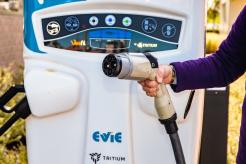The electric vehicle charging software and equipment industry is growing incredibly quickly — PWC projects that the EVSE market could grow from its current $7 billion value to $100 billion by 2040. All that growth and competition may compel businesses with EV charging stations to switch from one provider to another for various reasons.
Migrating from one platform to another can be a complex process, and businesses need the right strategies to ensure the transition is as smooth as possible. This guide will break down the steps necessary to migrate effectively from one EV charging platform to another. Let’s dive in!
Reasons for Migrating EV Charging Platforms

(Photo by Kindel Media)
1. Outdated technology
A common reason for an EV charging platform migration is the rapid pace of technological advancement, which leads to the introduction of newer and more efficient products in the market. As technology evolves at a dizzying pace, companies must stay up-to-date with the latest trends to ensure that their customers receive reliable services. Failure to do so can result in subpar performance, leading to dissatisfaction and reduced revenue.
2. Increased demand
Demand is increasing for faster and more efficient charging solutions as the industry grows and more people purchase EVs. The need to keep up with this influx of customers necessitates migrating to platforms that can handle the new demand levels, providing the high-quality services that customers expect.
3. Cost reduction
By switching to more efficient charging systems, companies can lower operational costs and reduce energy consumption. Businesses can pass these cost savings on to customers through cheaper rates or better services, increasing customer satisfaction and loyalty.
4. Inadequate functionality
Migration becomes necessary to maintain optimal performance if the current system can no longer meet the business’s or its customers’ needs. This is essential for ensuring that the company remains competitive and continues to provide high-quality services to its customers.
5. Inefficient operations
Migrating to a new platform can also help businesses streamline their operations and make them more efficient. By using the latest technology, companies can automate certain processes, reduce manual labor, and eliminate human errors, resulting in faster customer charging times and a better user experience.
6. Integration with other systems
Finally, migrating to a new EV charging platform can help businesses integrate their system with other existing solutions, creating a unified and seamless customer experience and providing more accurate data collection and analysis. This integration enables companies to optimize their operations and make informed decisions that benefit the business and its customers.
Steps to Migrating EV Charging Platforms

(Photo by Pixabay)
Now that we’ve discussed why a business might need to migrate to a new EV charging platform, let’s look at the steps necessary for an effective transition.
1. Define the scope and requirements of the project
Proper planning and preparation are critical to a successful EV charging platform migration. Defining the scope of your migration involves a deep understanding of the current system, a thorough analysis of customer needs, and establishing the migration’s objectives. This process is critical in ensuring a successful migration and demands high expertise.
2. Choose a new EV charging platform
Choosing the right platform should be based on cost, scalability, features, user experience, and ability to integrate with existing systems. Businesses should also consider customer feedback when selecting a platform to ensure it meets their needs.
3. Perform a risk assessment
Before migration, businesses should perform a comprehensive risk assessment to identify potential issues and develop solutions. Companies must be cautious about anticipating and addressing technical issues that may arise during the migration process, including troubleshooting errors and resolving compatibility issues between the old and new systems. By proactively managing risks, companies can ensure a smooth and successful transition with minimal customer disruption.
4. Prepare for the migration process
Preparation includes testing the new platform to ensure it meets their needs and training staff to use it. Data transfer issues are the most common challenges of EV charging platform migration. In some cases, this can require manual input or reformatting, leading to costly delays in the project timeline. So, you must ensure all customer data is securely transferred before the migration to avoid security breaches.
Choosing the right migration partner is essential for success. Businesses must seek out partners with extensive experience in EV charging platform migration and sufficient resources to guarantee a smooth transition. The chosen provider should offer adequate training and support to team members and customers during and after the process, including providing clear information on the migration and updates on its progress. Businesses can ensure customers’ satisfaction and loyalty during the transition by keeping customers informed.
5. Execute the migration
Next, businesses will need to execute the actual migration process. During this time, companies should monitor the progress of the transition and communicate any changes or issues to customers as required. After migrating, businesses must also contend with integrating the new platform with their existing infrastructure. This integration ensures the new system is compatible with current hardware, software, and communication networks. Inadequate integration can lead to slow charging times and customer data loss.
6. Test and validate the new platform
Testing and validating the new EV charging platform is vital to ensure it meets the needs of customers and businesses alike, including conducting user testing, performance tests, and security audits. Companies must also consider user adoption when migrating EV charging platforms, including providing customer training, support, and clear communication about the process. By doing so, businesses can ensure a smooth transition with minimal disruption to customer service while also guaranteeing their new platform is safe, secure, and ready for use.
7. Provide ongoing support and maintenance
Finally, businesses must have an ongoing support and maintenance plan for the new system, including regularly monitoring system performance and security and providing regular updates and bug fixes. By doing so, businesses can ensure their EV charging platform continues to operate smoothly and efficiently.
Do you want to learn about the latest EV technologies? Join us at the upcoming EV Charging Summit & Expo!






